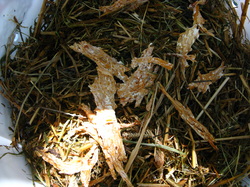|
This weekend, I got a chance to check my garden at the cottage. It's been two weeks, so I was excited and also a little nervous to check it out. Instead of tilling the ground like usual, I used sheet mulching to layer compost/cardboard/organic material and planted the seeds on top. This definitely has benefits, but it has a downside that I didn't realize: the raccoons clearly liked something that was underneath the cardboard layers. I assume it was an eggshell or some kind of delicious, rotting vegetable that I used as my base layer. Luckily, the coons didn't totally rip up everything, but they did damage a small piece of it. But besides that, things are growing! My peas are growing the fastest, but there are the sprouts of carrots, basil, and I think spinach. I know to most people this wouldn't be a big deal, but I was actually really proud that my seeds are doing okay (despite the fact that I planted them in an area teeming with wildlife and abandoned them for two weeks).  My original blue oyster mushrooms at home Over the weekend, I also transplanted my blue oyster mushrooms outside. A few months ago, I started growing mushrooms in my apartment. It started out in a medium sized jar, as you can see from the photo. However, several months later and a few fruitings later, it was taking over the container. My apartment doesn't have a lot of sun (or space), and I was running out of glass bowls to put it in. I decided that this weekend was time to either kill the mushroom entirely, or transplant it outside. I was kind of emotionally attached to my fungus, as weird as that sounds, so I felt like I should give it more space to live and make more food for me. In March, when it first produced fruit (what you think of when you eat a mushroom), I put some of it in a stew. I didn't die, so I think it's fine to eat them again. When I first started growing the mushrooms, I really didn't know what to expect, or when I would know when it's good to eat. This is a cool time-lapse video that I found that shows how blue oyster mushrooms grow. From what I've read, the fruit isn't supposed to be so long and spindely - this indicates that that mushroom needs more oxygen.  I made a holey bucket! As a wildlife biologist, my main concern was that mushrooms that I released outside would end up taking over other species and become an alien invasive species. First I did some research and asked a few mushroom experts if it was relatively safe for me to put them outside. Blue oyster mushrooms aren't native to this area, but there are a few related species. Apparently one important point is that they feed on dead material (prefrably straw or wood chips), so there's no danger of it attacking a living species. To grow oyster mushrooms outside, I had to drill holes into a bucket. Then, I layered hay with broken up pieces of mushroom mycellium (the body of the mushroom). I was initially looking for straw, but I had a really hard time finding it in the country, which surprised me. A friend had some hay at their farm, so I was lucky enough to snag some of the leftovers.  Layers of mycellium and hay in the bucket It actually took me relatively little time to make a holey bucket and layer it with hay and mycellium. The hardest part was getting the supplies. Once I closed my bucket, I put it in a sunny area (but not full sun). I'm not sure if this is the best location for the mushrooms, but I thought it might be a good place to try it out.
0 Comments
|
About ShonaI'm an eco-conscious girl from Montreal, Quebec. I'm currently an adjunct science professor at Champlain College of Vermont (Montreal Campus). I'm interested in any opportunities to expand my experience with grassroots activism, climate change legislation, or environmental education. Archives
March 2016
Categories
All
|

 RSS Feed
RSS Feed
